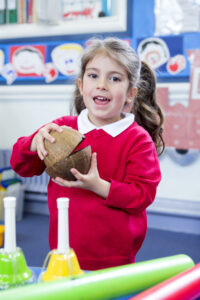Thank you to Get Set! Piano author Karen Marshall for the below guest post.
Teaching music through rhymes
One of the most successful ways to teach rhythm is through rhyme and if the rhyme has silly words – even better. How often is a tricky rhythm corrected once words are added? Here is one of the most successful rhymes I have used with children, with ideas on how to use it. It was first introduced to me on a Kodály course – do check them out on the British Kodály Academy website.

Teddy Bear – foundation up to the end of key stage 1
Teddy Bear Teddy Bear turn around
Teddy Bear Teddy Bear touch the ground
Teddy Bear Teddy Bear climb up the stairs
Teddy Bear Teddy Bear say your prayers
Teddy Bear Teddy Bear switch off the light
Teddy Bear Teddy Bear say goodnight.
This is great for teaching the difference between pulse and rhythm, once the children are able to say the rhyme I then:
- Get them to mark the pulse with a teddy bear bouncing on their knees.
- Do the actions to the song.
- Clap the rhythm of the song using the ‘thinking voice’ – children say the words in their head then clap the rhythm.
- Explore the rhythm of the music using rhythm flashcards with words of the song underneath.
- Practise the rhythms using Kodaly time names. Ta for crotchet, te te for quavers
- Practise the rhythms using Dalcroze actions. Walk for crotchet, jogging for quavers
- Get the children to improvise a melody to go with the words of the melody either by singing or using tune percussion (a pentatonic scales works best C D E F G). Boom whackers can also be fun to use.
Cross curricular – link in with the children’s key stage 1 toys project, write their own poem about a teddy bear or use the poem as a starting point for a story.
Karen Marshall teaches music in a York state primary school from reception to Year 6. She is a Kodály practitioner, private and peri piano teacher and special needs trained. She is the co-author of Collin’s Music’s Get Set! Piano and is currently writing First Get Set! Piano for 5 to 7 year olds.



